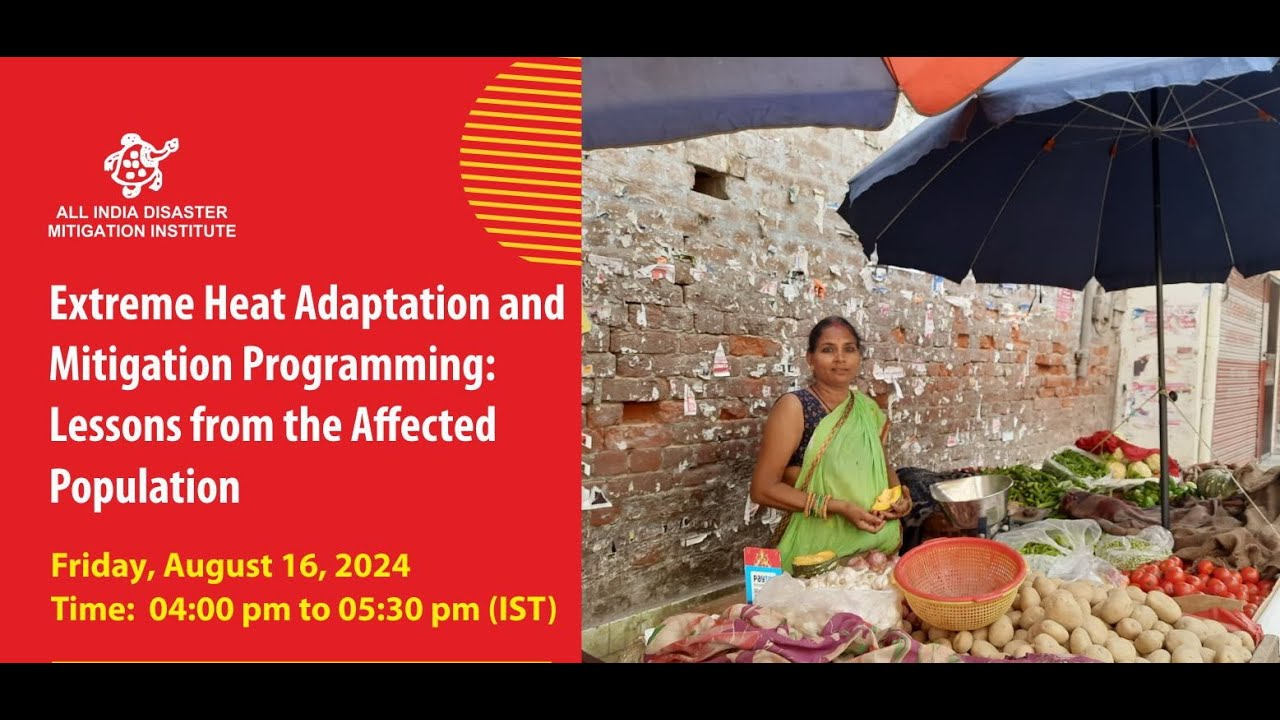As climate change accelerates, extreme heat adaptation has become a critical focus for communities globally, particularly in regions facing relentless heatwaves like Ahmedabad, India. With rising temperatures threatening both lives and livelihoods, innovative solutions such as heat action plans are being implemented to combat the negative effects of extreme heat on worker health in heat. Researchers and grassroots organizers are collecting vital data to understand how high temperatures impact communities and ecosystems, advocating for effective temperature monitoring strategies to address these challenges. These efforts not only highlight the risks associated with prolonged exposure to heat but also empower workers to navigate and mitigate climate change impact. By harnessing this knowledge, stakeholders can develop actionable strategies to bolster resilience in the face of increasing heat waves.
In an era where our world grapples with rising temperatures, developing ways for communities to respond to scorching heat has never been more essential. Strategies aimed at fostering resilience under extreme heat conditions resonate across various fields, from public health to urban planning. As cities begin to formulate guidelines and frameworks to protect their most vulnerable populations, the need for comprehensive planning becomes increasingly evident. Understanding how to safeguard worker well-being during harsh heat spells will guide the conversation around sustainable practices and community advocacy. Leveraging advanced research and local insights is paramount to forge a path that prioritizes health and safety amidst the challenges posed by global warming.
Understanding Extreme Heat and Its Impacts
Extreme heat has emerged as one of the severe consequences of climate change, leading to a host of health issues, economic challenges, and lifestyle disruptions. In regions like Ahmedabad, India, temperatures routinely soar beyond safe thresholds, prohibiting normal human functioning and impacting worker health significantly. As the climate continues to shift, cities must develop robust heat action plans that address the multifaceted dangers posed by rising temperatures. For workers exposed to these conditions, the risks extend beyond immediate heatstroke, impacting heart rates, kidney functions, and overall well-being.
These implications are not just felt at an individual level; they resonate throughout communities, impacting productivity, healthcare costs, and social stability. For instance, farmers and laborers may find it increasingly challenging to perform tasks effectively in unbearably hot conditions. The ongoing research led by Harvard emphasizes the importance of data collection in identifying and responding to these risks. By understanding how extreme heat affects daily life, policymakers can tailor interventions that prioritize the well-being of the most vulnerable workers.
The Role of Heat Action Plans in Mitigating Risks
Heat action plans are critical strategies developed by municipalities to reduce vulnerable populations’ exposure to extreme temperatures. Following Ahmedabad’s pioneering implementation of such a plan, more cities are recognizing the importance of proactive measures in saving lives. These plans include public awareness campaigns, medical training on heat-related illnesses, and community-based projects to improve access to cooling resources like drinking water and shaded areas. However, an important aspect often overlooked is the disproportionate impact of heat on informal workers who lack the same access to resources.
While urban heat action plans establish foundational support, they must be inclusive of all populations including those in the informal sector. Adequate training and education about heat risks are vital not just for medical professionals but also for workers who encounter extreme conditions daily. Additional strategies, such as the implementation of affordable heat-reflective materials or facilitating shade provisions in public spaces, can create safe working conditions, thus enhancing worker resilience against the relentless heat.
Empowering Workers Through Data Collection
Data plays a fundamental role in understanding the extent of heat’s impact on worker health in regions facing severe climate challenges. Harvard researchers are utilizing ground-level data collection to capture the realities that millions of workers experience in their homes and workplaces. By deploying sensors and wearables like Fitbits, researchers can gather precise temperature and health metrics that accurately represent these workers’ lived experiences. This wealth of information will inform the development of adaptive measures tailored to local needs.
As organizations amplify their efforts to gather meaningful data, civil society can advocate more effectively for policy changes. This participatory approach ensures that those most affected by extreme temperatures have their voices heard, as the data serves as evidence for necessary interventions. For example, associations of informal workers can leverage this data to demand better protective measures and appropriate legislative changes, thereby enabling them to work safely without compromising their health or livelihoods.
Innovative Solutions for Extreme Heat Adaptation
Innovative responses to the challenges posed by extreme heat are critical for fostering resilience among vulnerable populations. Community-led initiatives, such as parametric heat insurance, illustrate how local solutions can address real-world problems. By offering financial safety nets during peak heat events, these policies allow workers to rest without losing income, critically supporting their health and economic stability. Additionally, affordable construction techniques, such as painting roofs white to reflect sunlight, help combat the heat within communities, showcasing how adaptation can be both practical and innovative.
Moreover, grassroots organizers and researchers can collaborate to implement interventions that are social and culturally relevant. For instance, installing ventilation systems in homes can improve internal conditions, reducing heat accumulation that exacerbates stress during hot months. By focusing on community-driven adaptations, cities can effectively mitigate heat’s impact while empowering the very populations hardest hit by climate change, fostering a culture of resilience that prepares them for future challenges.
Monitoring Temperature for Health Safety
Temperature monitoring strategies are crucial in understanding the environmental conditions that affect worker health and safety. In regions like Ahmedabad, researchers have found significant discrepancies between temperature readings at official weather stations and the true conditions in densely populated urban areas. By employing localized temperature monitoring, stakeholders can ascertain not just the heat levels workers are exposed to throughout the day, but also the worst times for work due to heat stress. This accurate data can drive immediate actions within communities to enhance protection and promote safe working hours.
Furthermore, the development of wearable technologies that continuously monitor individual body metrics allows for real-time responses to heat exposure. For example, data collected from Fitbits or similar devices can indicate when someone is exceeding safe heat thresholds, prompting necessary breaks or cooling measures. The integration of personal health data with environmental monitoring creates a comprehensive understanding that empowers individuals and communities to make informed decisions about their work practices, ensuring their health is safeguarded against the risks of extreme heat.
Understanding the Effects of Climate Change on Worker Health
The interconnectedness of climate change, extreme heat, and worker health highlights the urgency of addressing these issues comprehensively. As heatwaves intensify due to climate change, it is imperative to prioritize the health of workers who are disproportionately affected. Their unique vulnerabilities necessitate tailored health interventions that account for not only immediate risks like heatstroke, but also long-term health complications related to ongoing exposure to extreme temperatures. Protecting these workers will require a multifaceted approach that combines research, policy implementation, and community engagement.
Additionally, understanding how climate change influences ecosystem dynamics is crucial. For example, extreme heat can alter local agriculture, impacting food security for laborers and their families. As crops wither under extreme conditions, farmers struggle to sustain their livelihoods, further pushing them into economic hardship. By studying these effects meticulously, stakeholders can forecast changes and develop strategic programs that address both agricultural resilience and worker health, creating a holistic response to the pressing challenges presented by a warming world.
The Importance of Grassroots Collaboration
Grassroots collaboration has proven vital in tackling the challenges posed by extreme heat and its impact on workers. The integration of local knowledge and resourcefulness with academic research fosters a participatory approach essential for success. In Ahmedabad, partnerships between Harvard researchers and community leaders have allowed for the collection of valuable data that reflects the realities faced by local workers. This collaboration not only builds trust within communities but also empowers them to participate actively in the adaptation strategies being developed.
Moreover, grassroots collaboration enables the identification of culturally relevant solutions that resonate with the local population. When local community health workers actively engage in projects to address extreme heat, their efforts can more effectively connect with the needs of vulnerable populations. This localized approach ensures that solutions are not only informed by science but also aligned with the experiences, traditions, and lifestyles of the individuals affected, enhancing the likelihood of successful implementation.
Advocacy for Inclusive Heat Action Plans
The need for inclusive heat action plans that consider the unique challenges faced by informal workers is more pressing than ever. While many cities in India have initiated measures to mitigate heat’s impact, there remains a significant gap in addressing the needs of those lacking formal employment protections. Advocacy efforts must emphasize the inclusion of informal sectors within heat action plans to safeguard the health and livelihoods of all community members. Ensuring that policies reflect the varying realities of informal workers will strengthen responses to extreme heat.
Incorporating input from those directly impacted by heatwaves into the planning process fosters a sense of ownership and accountability within communities. When workers from various sectors can join in dialogue about temperature impacts and share their lived experiences, it can inspire tangible changes in policy frameworks. By prioritizing inclusivity in advocacy, cities can create comprehensive heat action plans that not only mitigate risks but also empower vulnerable populations to adapt to their evolving environments.
Creating a Sustainable Future Through Adaptation
In the face of unprecedented climate challenges, creating a sustainable future hinges upon our ability to adapt to extreme heat effectively. As cities like Ahmedabad grapple with rising temperatures, adopting innovative, sustainable practices becomes a pressing necessity. Initiatives such as urban greening, enhancing shade in public spaces, and promoting sustainable building designs lay the groundwork for long-term adaptation strategies that can benefit workers and communities alike. These measures reduce heat retention, improve air quality, and enhance the overall livability of urban environments.
Moreover, building a sustainable future involves investing in resilient infrastructure that can withstand the adverse effects of climate change. Enhanced transportation and water management systems can protect people from extreme heat while ensuring access to critical resources. By prioritizing investments in sustainable adaptation strategies, cities can mitigate the impacts of climate change and foster resilience within their workforce, ultimately paving the way for healthier and more prosperous communities in the age of extreme heat.
Frequently Asked Questions
What are effective heat action plans for extreme heat adaptation?
Effective heat action plans for extreme heat adaptation include strategies that promote public awareness about heat risks, provide training for healthcare professionals to recognize heat-related illnesses, and increase the availability of resources like drinking water. Additionally, these plans often incorporate community-level initiatives such as monitoring local temperatures and humidity to better address the needs of vulnerable populations.
How does extreme heat adaptation impact worker health in heat?
Extreme heat adaptation significantly impacts worker health in heat by reducing heat-related illnesses and fatalities. Implementing changes like shaded workspaces, regular health check-ups, and providing access to hydration can help workers remain safe during extreme heat events, which are becoming more frequent due to climate change impacts.
What role does temperature monitoring strategy play in extreme heat adaptation?
Temperature monitoring strategies are crucial in extreme heat adaptation as they provide real-time data about local conditions. This data helps identify areas at risk for overheating, track the effectiveness of adaptation measures like white reflective roofs, and supports the formation of targeted health interventions to protect vulnerable populations during heat waves.
How do India’s heat waves affect communities and their adaptation efforts?
India’s heat waves have severe effects on communities, especially for informal workers who often lack adequate cooling solutions. Adaptation efforts in response to these heatwaves include formulating heat action plans, community education, and introduction of affordable solutions like heat-reflective roofing and access to heat insurance, which can mitigate the economic impacts caused by extreme temperatures.
What innovative solutions are being developed for extreme heat adaptation in response to climate change impact?
Innovative solutions for extreme heat adaptation in response to climate change impacts include parametric heat insurance, which provides financial support to workers during extreme heat events, and community initiatives that promote painting roofs white to reflect heat. These solutions aim to alleviate the health burdens and economic losses associated with high temperatures, particularly in developing regions like India.
| Key Points |
|---|
| Extreme heat is becoming more frequent and lasting longer, especially in urban areas like Ahmedabad, India. |
| Harvard researchers are collecting data with local grassroots organizers to inform adaptation and policy solutions. |
| Data is gathered using sensors and Fitbits to monitor health, with a focus on how high temperatures affect daily life. |
| Innovative policy responses include heat-reflective roofs, parametric heat insurance, and community heat action plans. |
| The study aims to fill gaps in knowledge about heat’s impacts on informal workers, who are often overlooked in policy solutions. |
| Public awareness campaigns and training for healthcare workers have been part of implementing heat action plans since 2010. |
| Community trust is essential for the success of the research and implementation of adaptation strategies. |
| The study is expanding to other parts of India as they gather empirical data on health risks related to climate change. |
Summary
Extreme heat adaptation is crucial as climate change leads to increasingly dangerous temperatures that affect millions of people, particularly in regions like Ahmedabad, India. Harvard researchers, in collaboration with grassroots organizations, are addressing this urgent issue by collecting vital data to inform effective adaptation strategies. By employing innovative approaches, such as the use of sensors and community-led heat action plans, they aim to enhance awareness and promote resilience against heat-related health impacts. This grassroots understanding is essential to ensure the safety and livelihood of vulnerable populations facing the dire consequences of extreme heat.









